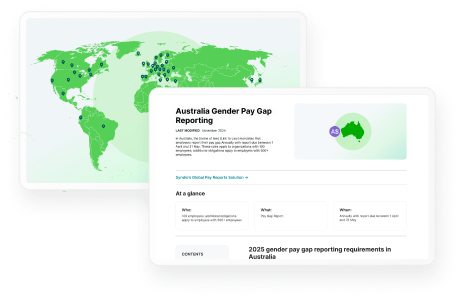Sweden’s Discrimination Act of 2008 requires employers to prepare an annual report on gender pay gaps. Employers with 10 or more employees are required to prepare a written report, with additional documentation required for those with 25 or more employees. As an EU Member State, Sweden’s pay gap reporting obligations will be modified by the EU Pay Transparency Directive — draft legislation became available on 29 May 2024.
Sweden Gender Pay Gap Reporting: What You Need to Know
LAST MODIFIED: October 24, 2025


At a glance
Who:
10+ employees, with additional obligations for employers with 25+ employees
What:
Pay Gap Report, EU Pay Transparency Directive
When:
Annual, with due date determined by employer
2025 gender pay gap reporting requirements in Sweden
When is Sweden’s gender pay gap report due?
The Swedish gender pay gap report is due annually. There is no fixed date, so employers can choose when to report.
Who needs to report on pay gaps in Sweden?
All employers in Sweden must summarize wages and identify wage differences between women and men who perform work that is to be considered equal or equivalent. Employers with 10+ employees in Sweden must prepare a written report that evaluates pay gaps between women and men.
For employers with 25+ employees, additional evaluation of active measures related to pay gaps and hiring, promotion, working conditions, and other dimensions of the employee lifecycle are also required.
What pay gap metrics do I need to report in Sweden?
The Sweden pay gap reporting law requires employers to analyse pay differences in three categories:
- Equal work analysis: Compare pay for men and women performing equal work (e.g.,employees in the same role.) This analysis should compare individual employees to one another and the “entire salary difference” must be explained objectively.
- Equal value analysis: Assess pay differences between 1) a group of workers who perform work that is or is usually considered to be female-dominated (i.e., where the group has at least 60% women) and 2) a group of workers who perform work that is considered equivalent to such work but is not or is not usually considered to be female-dominated.
- Lesser value / diametrical analysis: Assess pay differences between 1) groups of employees performing work that is, or is generally considered to be dominated by women (i.e., groups that are 60% or more female) and 2) groups of employees performing work that is not, or is generally not considered to be, dominated by women, but that gives higher pay despite the requirements of the work being regarded as lesser.
If you’re a Syndio customer using Global Pay Reports, you’ll receive a detailed data template to help you prepare your report. You can also ask Expertise On Demand, Syndio’s expert AI, for country-specific guidance whenever you need it.
Where do I need to share the Sweden pay gap report?
The Swedish Discrimination Act does not mandate public disclosure, but employers must share their report with worker representatives for collaboration on pay equity initiatives. The report is also subject to inspection by the Discrimination Ombudsman (DO).
Syndio’s Global Pay Reports help you centralize and automate reporting for 35 jurisdictions across 43 countries, including Sweden. Our software makes reporting easy, fast, and accurate so you can report with confidence, even as requirements change. And our services team can answer all your detailed questions — we’re experts so you don’t have to be.
Request a demo of Syndio's Global Pay Reports software.
Employers in Sweden and the EU Pay Transparency Directive
The EU Pay Transparency Directive will have a significant impact on Sweden’s current gender pay gap reporting requirements. On 29 May 2024, the Swedish Ministry of Labor and Employment received the investigative report into the implementation and transposition of the EU Pay Transparency Directive. This report includes draft legislation.
To stay current on the status of all 27 EU Member States, follow Syndio’s EU Pay Transparency Directive Transposition Tracker.
Each Member State will either meet or exceed the Directive’s minimum requirements when they transpose it into national law by June 2026. Additional pay transparency obligations may also be introduced for Sweden under the Directive. This includes requiring employers to disclose pay ranges to job applicants, prohibiting inquiries into salary history, and enforcing the Right to Information. The Right to Information allows employees to request details about their own pay and the average pay of male and female colleagues doing the same work or work of equal value to their own role.
Syndio provides a comprehensive solution for the EU Pay Transparency Directive with everything you need to plan, prepare, and comply. Learn more ->
How Syndio supports compliance with global pay equity, pay reporting, and pay transparency regulations
Syndio provides the technology and expert partnership you need to comply with the growing pay equity, pay reporting, and pay transparency requirements around the globe.
- Report your pay data and pay gaps — with Syndio’s Global Pay Reports. Our software supports fast, easy, and accurate compliance with pay reporting in 35 jurisdictions across 43 countries, including Sweden and for the EU Pay Transparency Directive. Syndio also supports the EU’s CSRD reporting.
- Run legally defensible pay audits — with Syndio’s PayEQ. Our suite of solutions give you the tools and compliant methodologies to analyze, explain, and resolve pay and career advancement gaps.
- Pay everyone consistently — with Syndio’s Pay Finder. On-demand pay recommendations help managers and recruiters make fair, consistent pay decisions that don’t exacerbate unlawful disparities.
- Create a customized action plan — with Syndio’s EU Readiness Strategy Package. Syndio’s team of experts help you build a custom strategy and support project management. This includes a change management strategy session for senior leaders, communications strategy session on pay gap and Right to Information, and ongoing support on best practices and trends.
- Craft tailored communications strategies — with Syndio’s Communications Package. Leverage best practices to build a communications plan that builds your brand while aligning to your values and objectives.
Syndio takes data privacy and security seriously. Syndio is GDPR compliant, SOC 2 Type II and ISO 27001 2022 certified, and has completed the Cloud Security Alliance CAIQv.4.02 security self-assessment for STAR Level One. Learn more in our Trust Center under “Security Reports.”
FAQ: The most asked questions about Sweden’s gender pay gap reporting
Syndio helps customers all over the world with their global pay reporting needs. Here are some common questions we get about the reporting requirements under Sweden’s pay gap law.
The information provided on this resource does not and is not intended to be legal advice. All information, content, and materials are provided for general informational purposes only. The links to third-party or government websites are offered for the convenience of the reader; Syndio is not responsible for the contents on linked pages.
Subscribe
Join our community and stay up to date on pay reporting transparency.
Top pay reporting resources
Syndio’s Global Pay Reports
Learn how Syndio simplifies reporting for 43 countries around the world.
Pay Data Reporting Calculator
Learn where your company must report pay gap data.
